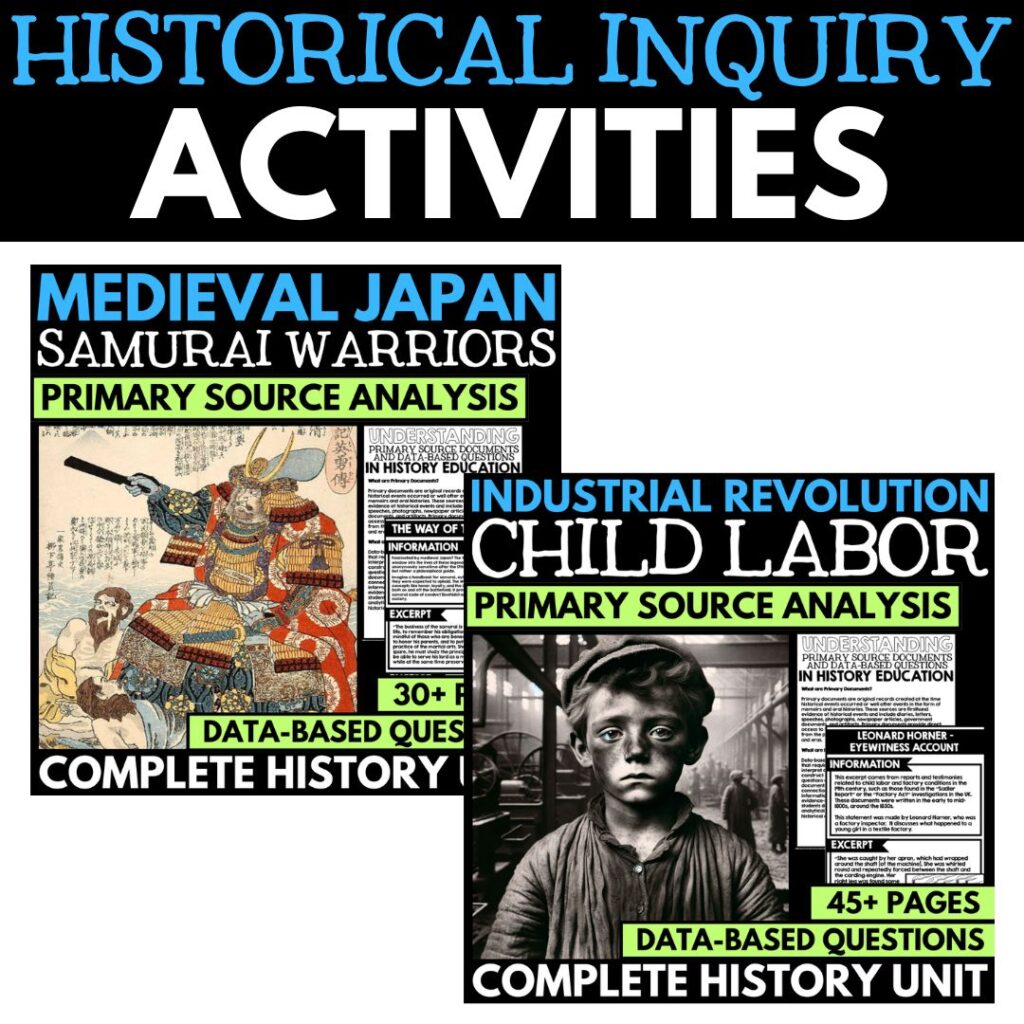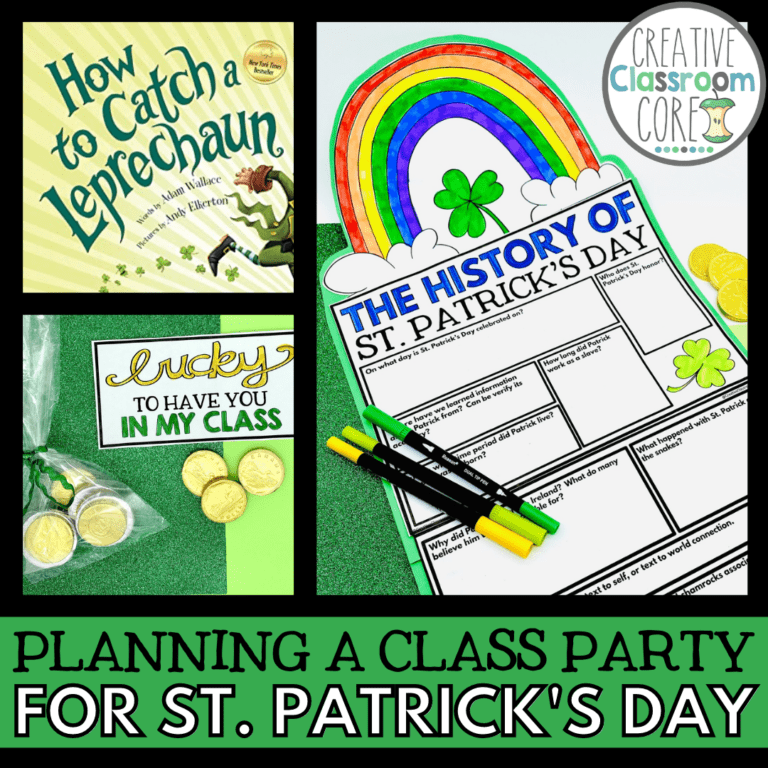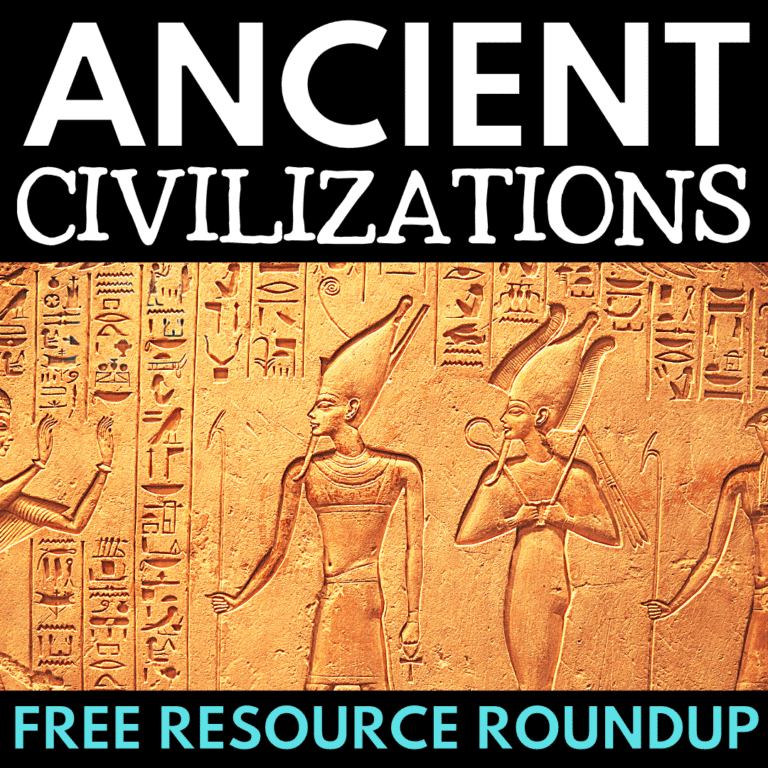What is Historical Inquiry?
By MARISSA DESPINS Updated June 11, 2024
Using Historical Inquiry in the Classroom
Engaging students in historical inquiry transforms the classroom into a dynamic environment where history comes alive. Rather than merely memorizing dates and events, students delve into the past, investigating questions, analyzing primary sources, and constructing their own interpretations of historical events. This approach not only deepens their understanding of history but also hones critical thinking, research, and analytical skills. In this blog post, we’ll explore practical strategies for integrating historical inquiry into your lessons, empowering your students to become inquisitive historians who can think critically about the past.
Looking for some print and go resources to help you teach engaging lessons using historical inquiry that incorporate primary documents and data-based questions? Click on the image or button below to see the resources available in my TPT shop!
What is Historical Inquiry?
Historical inquiry is an educational approach that immerses students in the process of investigating and interpreting the past. Rather than passively receiving information, students actively engage in questioning, analyzing, and synthesizing historical data. Central to this method are primary documents and data-based questions, which serve as the foundation for exploration. Primary documents—such as diaries, letters, photographs, and official records—provide firsthand accounts of historical events, offering invaluable insights and perspectives. Data-based questions challenge students to critically analyze these sources, draw connections, and formulate evidence-based conclusions. Through historical inquiry, students develop a deeper understanding of history and cultivate essential skills in critical thinking and analysis.
What are Primary Documents?
Primary documents are original records created at the time historical events occurred or well after events in the form of memoirs and oral histories. These sources are firsthand evidence of historical events and include diaries, letters, speeches, photographs, newspaper articles, government documents, and artifacts. Primary documents provide direct access to the thoughts, perspectives, and experiences of people from the past, offering invaluable insights into historical events and eras.
What are Data-Based Questions?
Data-based questions (DBQs) are questions that require students to analyze and interpret data from primary sources to construct an informed response. These questions often involve multiple primary documents and ask students to draw connections between them, synthesize information, and provide evidence-based arguments. DBQs help students develop critical thinking and analytical skills by engaging with real historical data.
What is the Importance of Inquiry in the History Classroom?
In the history classroom, incorporating historical inquiry through data-based questioning strategies and primary documents is crucially important for a number of reasons.
1.They Allow Students to Engage with Authentic Sources: Primary documents bring history to life by allowing students to engage with the actual words and artifacts of people who experienced historical events. This makes the study of history more tangible and relatable.
2. They help With Developing Critical Thinking Skills: Analyzing primary documents requires students to question the reliability and perspective of sources, identify biases, and consider the context in which the documents were created. This process hones their critical thinking and evaluative skills.
3. They Encourage Historical Inquiry: DBQs promote a deeper level of historical inquiry by challenging students to investigate historical questions, draw evidence-based conclusions, and support their arguments with specific examples from the documents. This method mirrors the work of historians and fosters a more investigative approach to learning history.
4. They Help Build Analytical Skills: Working with primary documents and DBQs helps students develop essential analytical skills. They learn to compare and contrast different sources, recognize patterns, and understand cause-and-effect relationships within historical contexts.
5.They Enhance Engagement and Interest: Using primary documents can make history more engaging and exciting for students. Handling real artifacts or reading original writings can spark curiosity and motivate students to learn more about the past.
6. They Help to Foster Empathy and Understanding: Primary documents offer personal perspectives on historical events, helping students to empathize with people from different times and cultures. This understanding can foster a deeper appreciation for diverse experiences and viewpoints.
What are some ways I can use this in the Classroom?
Integrating historical inquiry into the classroom involves creating opportunities for students to investigate and engage with history actively. Start by selecting compelling primary documents related to the unit you are teaching—these could be letters, photographs, newspaper articles, or official documents. Pose data-based questions that require students to analyze these sources, encouraging them to think critically about the context, purpose, and perspective of each document. Create collaborative projects where students work in groups to explore historical questions, draw conclusions, and present their findings. Incorporate activities such as role-playing historical figures, debating historical issues, and creating timelines to make the inquiry process interactive and immersive. By using historical inquiry, you help students develop a more nuanced understanding of history and foster a classroom environment that values curiosity and critical thinking.
Wrapping up
Incorporating historical inquiry into your classroom transforms the way students engage with history, turning it from a list of dates and events into a lively exploration of the past. By focusing on primary documents and data-based questions, you can help students develop critical thinking, research, and analytical skills. These strategies not only deepen their understanding of historical events but also foster a sense of empathy and a greater appreciation for diverse perspectives. With practical methods such as analyzing primary sources, collaborative projects, and interactive activities, you can inspire your students to become curious and thoughtful historians.
If you’re looking for ready-to-use resources to enhance your lessons with historical inquiry, be sure to check out the materials available in my TPT shop!
Interested in signing up for my email list?
If you are interested in signing up for my email list, you can do so by clicking on the link below. I periodically send out emails with free resources, teaching tips, and exclusive deals. Signing up will also give you immediate access to some of my best selling Interactive Notebook resources – foldable activities, graphic organizers, and other fun activities.









